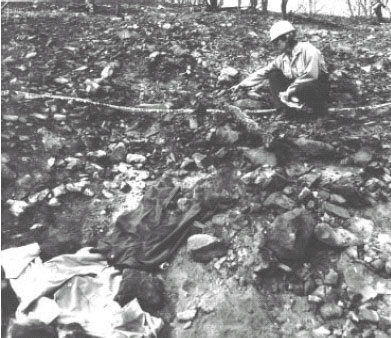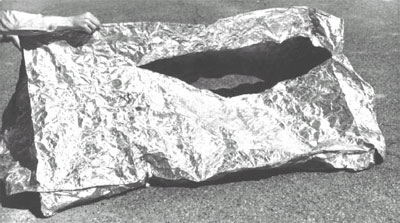
Tuolumne Fire
Helitack Crew 404 Burnover
Glen Allen Fire
Download 60-page Glen
Allen report, 4.6 mb pdf
Other Websites:
|
 |
United States Department of Agriculture
Forest Service
Technology & Development Program
April 1994
5100
9451-2335–MTDC |
Lessons Learned:
The Use of Personal Protective Equipment on
Wildland Fire Entrapments in 1993
Dick Mangan, Program Leader
During 1993, two wildland fire entrapments were investigated on-scene
by fire equipment specialists from the Missoula Technology and Development
Center (MTDC). One, a wildfire in California, involved nine firefighters;
the other, a prescribed burn in New Mexico, involved 16 firefighters.
Both fires offer some excellent “Lessons Learned” on the performance
and use of personal protective equipment (P.P.E.). While the size, locations,
fuel types, and burning conditions vary on wildland fires across the United
States, there are many similarities in the use of P.P.E. that allow all
firefighters to benefit from a review of these incidents (Fig.
1).
In the entrapments that will be discussed, the fire shelter was used
to protect some firefighters from high levels of radiant heat. Some of
the important lessons learned concerning fire shelter use in these entrapments
include:
-
Individuals are still trying to outrun flame fronts while carrying
heavy packs; they are seldom successful. When entrapment is imminent,
firefighters must get shelters out and get rid of packs, which slow
up escape and deployment and often ignite on the firefighters.
-
Two individuals successfully survived under one fire shelter (without
injuries) when one person was unable to deploy his shelter in a timely
manner.
-
People are still failing to lie on the ground before the flame front
catches them; the air within 18 inches of the ground is often sufficiently
cool to protect the respiratory system even when no fire shelter is
used.
-
One person was wearing gloves that were too bulky to allow shelter
removal from the carrying case without removing their gloves; others
had oily gloves, which slipped on fire shelter case pull tabs.

Figure 1.—On-site inspection of entrapment scene offers information
on the event.
-
Several fire shelters showed some sign of wear inside the clear polyvinyl
bags, but performed satisfactorily in use. These shelters were not
properly inspected prior to use.
-
Five individuals partially opened their fire shelters and used them
as heat shields to walk along a narrow jeep trail above the fire.
They did not fully deploy their shelters in the recommended manner
and may have endangered themselves by being in a zone where super
heated air and gases could have damaged their respiratory systems.
Their fire shelters provided cleaner air and shielded them against
some of the radiant heat.
-
A jeep trail 8 feet wide and a forest road 16 feet wide both provided
adequate areas to safely deploy fire shelters.
-
A fire shelter with a 3-foot tear caused by a person trying to get
under another person’s shelter still provided adequate protection
from the entrapped firefighters (Fig. 2).
-
Many individuals traveled along roads to larger safety zones while
inhaling harmful amounts of smoke and subjecting themselves to radiant
heat without deploying their fire shelters as shields.
Other Personal Protective Equipment
Other items of P.P.E. whose performance on these entrapments was worth
noting include:
-
Several individuals, attempting to outrun the fire on steep slopes,
lost their hardhats because they were not using the chin straps. Hardhats
can provide critical thermal protection for the head, reducing direct
exposure to radiant heat or actual flame.
-
Nomex shirts and overpants on several individuals were subjected
to temperatures in excess of 600° F; they functioned as designed
and provided thermal radiation protection to the individual involved.
-
One individual, who did not deploy his fire shelter, had his face
and neck shroud tucked inside his hardhat and failed to let it down
when entrapped. He suffered minor burns to his ears when the fire
burned by him.
-
In all cases, leather lace-up boots provided good protection for
entrapped firefighters and no injuries to the feet occurred. One person
was wearing plastic boots, which are hazardous in a fire environment,
do not meet minimum safety standards, and may contribute to foot injury.

Figure 2.—Even a damaged fire shelter provided protection for
two entrapped firefighters.
-
Close fitting face and neck shrouds restrict breathing and are uncomfortable
when the wearer is running. The lack of an insulating air layer between
the shroud and skin increases the heat load the wearer suffers. This
can lead to burns from direct contact with the shroud or from radiant
heat. At least one firefighter was so uncomfortable that he opened
the shroud while running from the fire in order to breathe easier.
-
Most line gear did not experience damage from the heat of the fire
itself, but some damage and burning did occur when flammable items
such as fusees or saw gas containers left in the firefighter’s
field pack caught fire (Fig. 3).
Fusees will self-ignite when reaching 375° F. The igniter portion
burns at 3,300° F and then the main portion of the fusees continues
to burn at 1,600° F. These temperatures far exceed the design
limitations of the P.P.E.
-
All individuals entrapped were wearing cotton or cotton/polyester
mix t-shirts. Both short-sleeved and long-sleeved versions were used.
Although charring occurred, no ignition resulted on these items and
the extra insulation between the Nomex outer shirt and the firefighter’s
skin reduced burn injury by about 15 percent.

Figure 3.—A line pack shows the effects of intense heat.
Recommendations
While wildland firefighters never expect to be entrapped on fire assignments,
the possibility always exists and actions to minimize injuries must be
anticipated with reactions planned in advance of the actual event. Actions
that could be critical to your survival in the event of an entrapment
include:
-
Select escape routes and safety zones carefully and consider the
potential rate of fire spread and fire intensity of the fuels in order
to have sufficient time to escape.
-
Always use all assigned P.P.E. in the method intended (i.e., sleeves
down on shirts, gloves on, etc.) (Fig. 4).
-
When entrapped with no escape route, the most important action to
insure survival is to get face down on the ground where cooler air
will help to protect your airway, even if you cannot get into your
fire shelter before the high heat arrives.
-
During an entrapment, always remove all flammable materials such
as fusees, saw gas containers, and oil-soaked packs immediately, even
if removal must be completed lying on the ground or in a shelter.
Push pack well away from yourself and others.
-
Never begin an operational period with clothing or P.P.E. that has
gas, oil, or other flammable materials on them.
-
Fire shelters should always be carried where they can be quickly
reached, even on the run. Shelters should never be carried inside
the firefighter’s field pack.

Figure 4.—Forest worker gloves protected the hands of firefighters.
-
Fire shelters should be inspected annually at the start of each fire
season and re-inspected on a regular basis throughout the fire season
(recommended re-inspections every 2 weeks). Specific information on
inspecting fire shelters can be found in the publication “Inspecting
Your Fire Shelter.”
-
Practice deployments so that you can properly deploy and be within
your shelter in under 25 seconds. Practice sites should include steep,
uneven ground. Large fans should be used to simulate the high wind
conditions that often occur on wildland fire entrapments.
-
Refresh your fire shelter training every year and completely retrain
every 3 years.
-
Face and neck shrouds should not be worn on a regular basis since
they cause heat stress and may tempt firefighters to take more chances.
They should be worn when previously safe conditions worsen and escape
or entrapment action becomes likely.
-
Firefighters should deploy shelters and lie on the ground in extremely
smoky conditions to minimize smoke inhalation, even when burn injury
is unlikely. A shelter may prevent minor burns and smoke inhalation.
- Although fire shelters are designed for a single occupant, they may
be used for two individuals if no other alternative exists.
For additional Information contact: Dick
Mangan, Program Leader, Missoula Technology & Development Center,
Bldg. 1, Fort Missoula, Missoula, MT 59801 Phone: 406-329-3849; FAX:
406-329-3719; DG–D.Mangan:R01A
The USDA Forest
Service has developed this information for the guidance of its employees,
its contractors, and its cooperating Federal and State agencies,
and is not responsible for the interpretation or use of this information
by anyone except its own employees. The use of trade, firm, or corporation
names in this publication is for the information and convenience
of the reader and does not constitute an endorsement by the U.S.
Department of Agriculture of any product or service to the exclusion
of others that may be suitable. |
|
